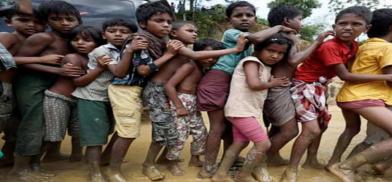Nearly 20 million Bangladesh children facing brunt of climate change
The future of over 19 million children in Bangladesh is at risk from climate change, according to the United Nations Children's Fund (Unicef)

The future of over 19 million children in Bangladesh is at risk from climate change, according to the United Nations Children's Fund (Unicef). According to the Global Climate Risk Index, Bangladesh ranked among the top 10 countries in the world most affected by extreme weather conditions between 1998–2021.
The environment platform The Third Pole, in a recent report, pointed out that South Asia is witnessing unprecedented impacts of climate change, including more frequent and intense extreme weather events, climate-induced migration, widespread crop failures and dramatic shifts in biodiversity.
Despite slowing down during the pandemic, global carbon emissions have continued to rise over the past two years. After the protracted public health crisis shifted attention and resources towards tackling Covid-19, climate change is now back on the agenda with greater urgency.
Bangladesh is among the countries most vulnerable to the impact of climate change. People face the fury of floods, cyclones, droughts, salinity and river erosion, and the poorer people are affected more than others.
As the Himalayan glaciers melt due to global warming, the sea level rises and the risk of catastrophic disasters increases in riverine Bangladesh, experts have said.
Globally, approximately 1 billion children (nearly half of the world's children) live in countries at extremely high risk from climate change, according to Unicef’s first child-focused Children Climate Risk Index, 2021.
Bangladesh has the 15th highest risk from climate change, according to the report.
Children in 20 districts across the country are most at risk, including the southwestern districts of Khulna, Satkhira, Bhola and Sirajganj.
When families affected by natural disasters lose their homes, the children of those families are often forced to join work to earn money. As a result, children are more likely to be victims of various forms of abuse.
There is a risk of missing children, victims of sexual abuse, child labor, trafficking, and unsafe migration during disasters.
Dr. Nazmun Nahar Nur, deputy director (DRR & CCA) at Save the Children International, told Dhaka Tribune: “Apart from child malnutrition, dropouts, child marriages, child labor and migration, one of the major issues is protecting children from the climate crisis in Bangladesh.
“Financial trouble due to natural disasters makes girls more likely to be harassed and abused in various ways. Many are sold into the sex trade. In the case of boys, they leave the village as children and move to the cities to engage in various hazardous occupations,” she added.
Save The Children has been working on the child-centered Climate Change Adaptation Project (CCCCA) for the last 8 years in Dhaka, Khulna and Sirajganj.
Muzammel Haque, senior officer of the CCCCA at Save the Children in Bangladesh, said: “Unfortunately, Dhaka and other cities in Bangladesh are not well prepared for the influx of environmental and climate change migrants and relocating from climate-vulnerable locations may place children in a situation of one set of problems being replaced by another.”
Nazmun Nahar called for ensuring a green recovery program and restoration of biodiversity, increasing child-focused climate change projects and policies, ensuring climate change engagement in the national and international negotiations, ensuring climate change mitigation and countries’ commitment, and strengthening climate change and gender action plans.
(SAM)









Post a Comment